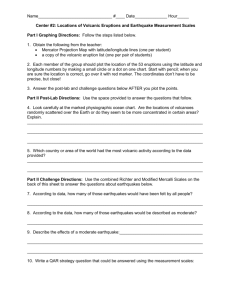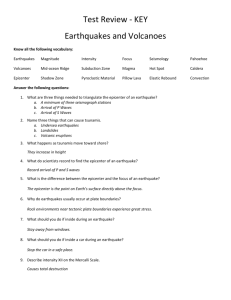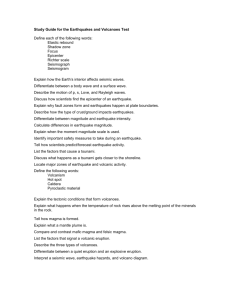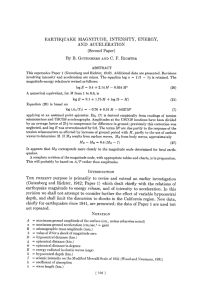Chapter 1 Learning Objectives
advertisement
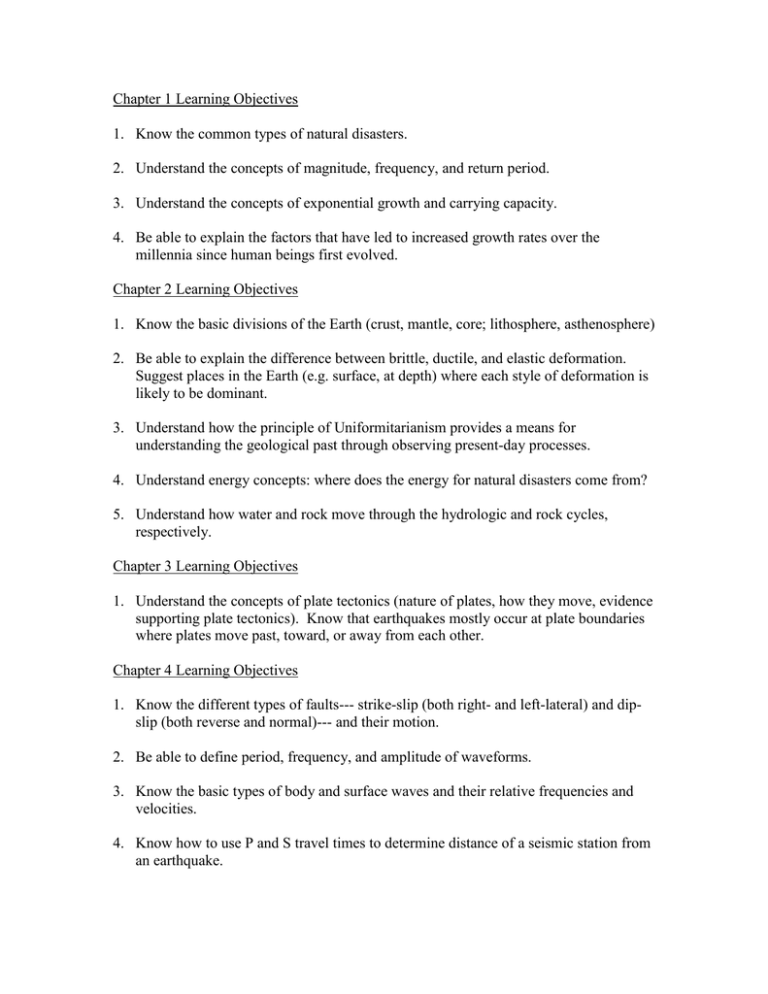
Chapter 1 Learning Objectives 1. Know the common types of natural disasters. 2. Understand the concepts of magnitude, frequency, and return period. 3. Understand the concepts of exponential growth and carrying capacity. 4. Be able to explain the factors that have led to increased growth rates over the millennia since human beings first evolved. Chapter 2 Learning Objectives 1. Know the basic divisions of the Earth (crust, mantle, core; lithosphere, asthenosphere) 2. Be able to explain the difference between brittle, ductile, and elastic deformation. Suggest places in the Earth (e.g. surface, at depth) where each style of deformation is likely to be dominant. 3. Understand how the principle of Uniformitarianism provides a means for understanding the geological past through observing present-day processes. 4. Understand energy concepts: where does the energy for natural disasters come from? 5. Understand how water and rock move through the hydrologic and rock cycles, respectively. Chapter 3 Learning Objectives 1. Understand the concepts of plate tectonics (nature of plates, how they move, evidence supporting plate tectonics). Know that earthquakes mostly occur at plate boundaries where plates move past, toward, or away from each other. Chapter 4 Learning Objectives 1. Know the different types of faults--- strike-slip (both right- and left-lateral) and dipslip (both reverse and normal)--- and their motion. 2. Be able to define period, frequency, and amplitude of waveforms. 3. Know the basic types of body and surface waves and their relative frequencies and velocities. 4. Know how to use P and S travel times to determine distance of a seismic station from an earthquake. 5. Know how earthquake epicenters are determined. 6. Know how Richter magnitude is determined, why its use is restricted now, and what other magnitude scales are preferred instead. 7. Know how Mercalli intensity is determined and why it is still used, despite the existence of several magnitude scales. Chapter 5 Learning Objectives: 1. Know and be able to explain the differences between tsunami, seiches, tidal waves and wind-blown waves. 2. Understand the velocities and periods of tsunami. 3. Understand the danger that tsunami momentum brings across the shore and well inland. Chapter 6 Learning Objectives 1. Know the configuration of plates and be able to make predictions of the most likely type of faulting to occur in various areas of western North America. 2. Know what lessons have been learned from some of the large earthquakes that have occurred in western North America (e.g. the importance of building design and materials and ground type, learned from the Loma Prieta and Mexico City earthquakes). 3. Be familiar with the elastic-rebound theory and modern understanding of the earthquake process. Chapter 7 Learning Objectives 1. Summarize the regions in North America where major earthquakes have occurred or are likely to occur. 2. For these regions, provide a plausible explanation of the cause(s) of the seismicity. 3. For each region, give at least one example of a significant earthquake. Chapter 8 Learning Objectives 1. Know how the process of decompression melting produces magma. 2. Understand the factors controlling magma viscosity and magma volatiles, and know how these factors are determined by the plate tectonic environment. 3. Know how the characteristics of eruptions depend on the three Vs (viscosity, volatiles, and volume). 4. Understand the similarities and differences between volcanic eruptions and geyser eruptions. 5. Understand how the volcanic explosivity index (VEI) is determined for an eruption. 6. Know the descriptive terms for eruptive style. Chapter 9 Learning Objectives 1. Know the potential hazards from a volcanic eruption (phenomena that can cause property damage or loss of life). Be able to provide specific examples/occurrences of these phenomena. 2. Appreciate the difficulties of prediction of volcanic eruptions: the potential public backlash if erroneous predictions are made and the potential loss of life or property if predictions are not made and an eruption does ensue. Chapter 10 Learning Objectives 1. Understand the factors that increase the instability of slopes and that can trigger mass movements. 2. Know how mass movements are classified into flows, falls, slides and subsidence, and be able to cite examples of each type of mass movement. Chapter 11 Learning Objectives 1. Understand the ways in which climate has varied over a) millions of years, b) thousands of years. Know how scientists are able to infer climate change over geological time, and how they can measure the magnitude of such change. 2. Understand the ways that energy can be re-distributed in the atmosphere (convection, conduction, and changes in state). 3. Understand the concept of relative humidity and how the relative humidity of an air mass is affected by changes in temperature and pressure. 4. Be able to explain the Coriolis effect and predict the curvature of paths of moving air or water masses. Also understand how it contributes to rotation of winds around high and low pressure centers. 5. Be able to explain how solar heating of the Earth and atmosphere, plus the Earth’s rotation, determine global wind patterns. Chapter 12 Learning Objectives 6. Understand the ways in which climate has varied over a) the last few thousand years, and b) the last few years. Be able to provide examples of each. Know how scientists are able to infer climate change over geological time, and how they can measure the magnitude of such change. 7. Understand the relationship between volcanism and climate. 8. Know what greenhouse gases contribute to global warming over the last and next century. 4. Understand the atmospheric factors leading to the development of a) mid-latitude cyclones and associated severe weather and b) thunderstorms and tornadoes. Be able to provide examples of severe weather and explain how dangerous their occurrence is. Chapter 13 Learning Objectives 1. Be able to describe the conditions necessary for hurricane formation and growth. 2. Several basic physical principles, for example latent heat and the Coriolis effect, are essential to understanding how a hurricane works. Be able to explain these principles and how they relate to hurricanes. 3. Understand how hurricane winds, waves, rain, and storm surge can cause damage and the strategies people can adopt to minimize such damage. 4. Know the factors that influence wave height, wavelength, breaking, and refraction. 5. Understand the ways in which waves remove and deposit sediment along coastlines, and the advantages and drawbacks of the methods people have used to control beach erosion and sand transport. Chapter 14 Learning Objectives 1. Know how streams respond to changes in sediment load, base level, or discharge in order to maintain an equilibrium profile. 2. Know how flood recurrence intervals are determined and be able to construct a flood frequency curve given peak yearly discharge data for a stream. 3. Know at least one example of a flash flood and a prolonged regional flood. For each, be able to discuss a) the cause(s) and/or exacerbating factor(s), b) mitigation efforts that were taken and their effectiveness, and c) mitigation strategies that should be adopted in the future. 4. Understand how human activities can change the flooding behavior of a stream. Chapter 15 Learning Objectives 1. Know the necessary constituents for fire (the fire triangle and the fire square), the sorts of chemical reactions that occur during combustion, and the stages of fire. 2. Be familiar with how conditions of wind, weather, topography, and fuel can influence the spread of fire. 3. Be able to discuss various strategies that have been used to reduce the negative effects of wildfire on people and properties. Know how and whether these practices have been effective, and what unintended consequences each may have brought about. Chapter 16 Learning Objectives 1. Appreciate the distinction between an extinction event and normal background levels of species extinction. 2. Be able to describe the Permian and Cretaceous extinction events, in terms of the types of organisms that died out and the possible causes. 3. Know how geologists assess the relative ages of rocks and fossils using the Law of Superposition, Law of Faunal Succession, and Law of Faunal Assemblages, and the absolute ages using radiometric dating. Chapter 17 Learning Objectives 1. Know the types and general locations of solar system objects that may be potential impactors. 2. Know how we can assess the frequency of past collisions and thus estimate recurrence intervals. 3. Know the types of evidence left in the rock record by impacts, both large and small. 4. Understand how impacts might contribute to mass extinction events. 5. Understand why the Spaceguard Survey is tracking near Earth objects (NEOs).


